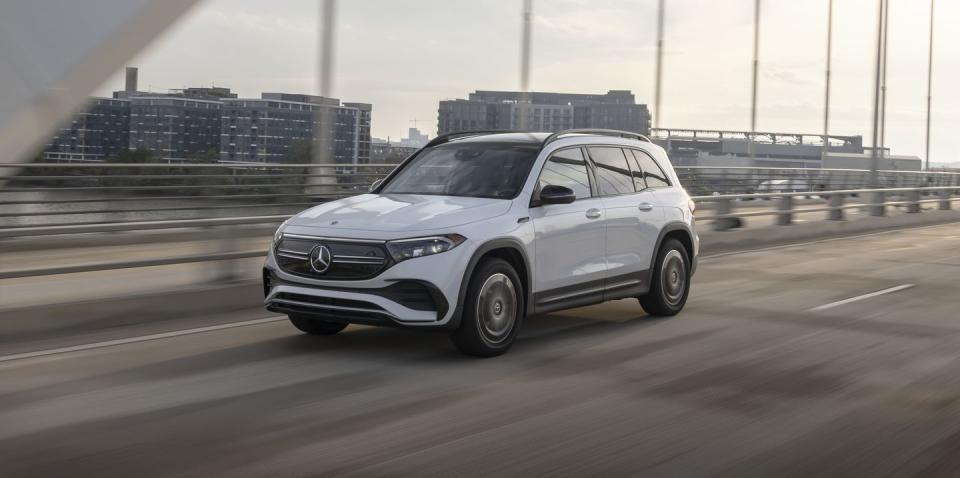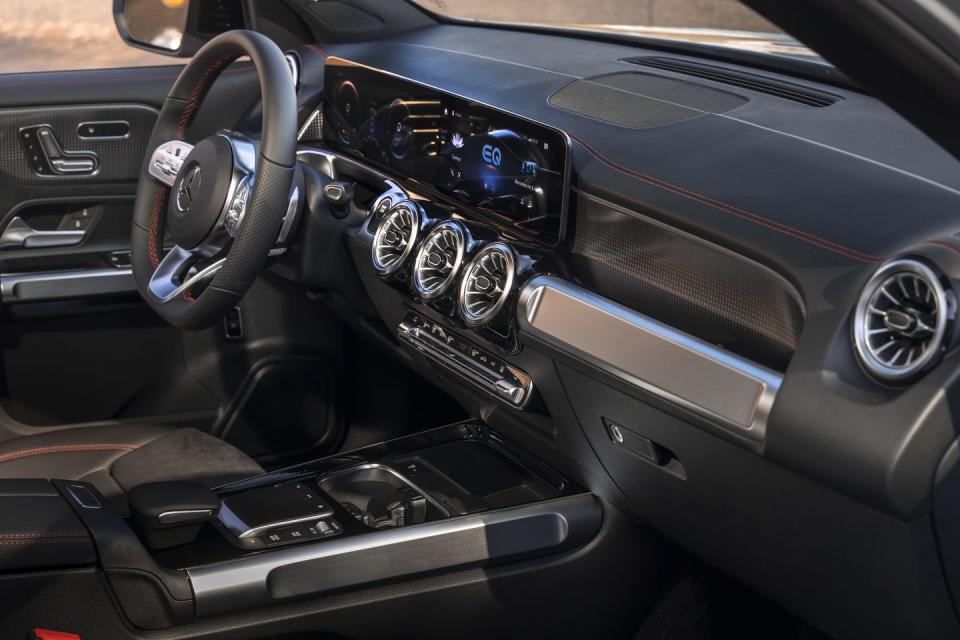’22 Mercedes EQB EV Lures Mainstream Buyers with Aggressive Pricing

The EQB is derived from the gasoline-powered Mercedes GLB midsize crossover, which needs all the sales help it can get in this fiercely competitive US segment.
One version of the EQB will offer 225 hp and the other 288 hp. Maximum speed for both models is 99 mph—they’re not designed to keep AMG pace on the autobahn.
With a 70.5-kWh battery, range for the EQB is estimated at 230 miles—well below more expensive rival models carrying heavier battery packs of at least 100 kWh.
Those currently shopping for a luxury battery-electric crossover have limited choices, including the Audi e-tron, BMW iX, Cadillac Lyriq, Jaguar i-Pace, Tesla Model X, and Volvo XC40 Recharge. But new offerings are on the way, such as the Lexus RZ and electric versions of the Porsche Macan and Range Rover.
The latest entry, arriving this summer in the US, is the all-electric Mercedes-Benz EQB, which is derived from the gasoline-powered GLB midsize luxury crossover. Spinning off an all-electric version makes good sense because the GLB needs all the help it can get in this fiercely competitive US segment, where its 11,500 deliveries through the first half of this year makes it a laggard.
The EQB's seemingly creaseless exterior may lack style—are there any great-looking crossovers, luxury or otherwise?—but the interior is well-appointed and comfortable and the drivetrain is smooth and capable with 225 hp and 288 lb-ft of torque in the EQB 300 4Matic we drove in southern Germany. Mercedes reports a 0-62 mph time of 8.0 seconds, which makes it slower than most of its rivals.
Thrill-seeking customers might steer instead toward a second version, the EQB 350 4Matic, which steps up to 288 hp and 384 lb-ft of torque, although through a fixed-ratio transmission. Both EQBs have a motor at each axle (but front-wheel biased) and use the same 420-volt architecture and offer a usable energy content of 70.5 kWh from the lithium-ion battery pack. Maximum speed in both EQBs is 99 mph—they’re not designed to keep AMG pace on the autobahn.

What matters to most EV shoppers is range, and the EQB’s anticipated 230 miles on a single charge (although not yet certified by the EPA) places it in good company. Some rivals top 300 miles of range, but with larger batteries of at least 100 kWh—including the BMW iX, Cadillac Lyriq, and Tesla Model X, all of which are well over 5000 pounds.
But you can save money buying an EQB with a smaller battery that reduces weight and still can handle a drive from Boston to Manhattan without recharging. Heavier curb weight makes for inefficiency—it means your EV will work harder to move that mass, depleting range. Another rival, the Audi e-tron 50 quattro, has a similarly sized 71-kWh battery, but it tips the scales at more than 5200 pounds while delivering up to 211 miles of range. That’s well below the EQB, which weighs in at a relatively slender 4718 pounds, with a full tank of gas.

As EV segments fill up in the coming years, we will see more of this strategic positioning as automakers seek the white space and try to create niches based on range, size, performance, price, and the user experience. But success is not assured. Mercedes has tried to market in Germany the EQC, an electric version of its GLC crossover. But the EQC has not done well and will be discontinued in spring. The EQB is meant to succeed where the EQC failed.
The EQC is not available in the US, but sales for its combustion-engine GLC counterpart surpassed 36000 units in the first half this year and the even larger GLE topped 32000.
EVs are having an impact in this segment that includes the Tesla Model Y (with 98,294 first-half sales), Ford Mustang Mach-E (17,675 sales), and Hyundai Ioniq 5 (13,692 sales). Based on a test drive of Mercedes’ newest production EV, chances are good the EQB will be warmly welcomed to the market.


 Yahoo Autos
Yahoo Autos 